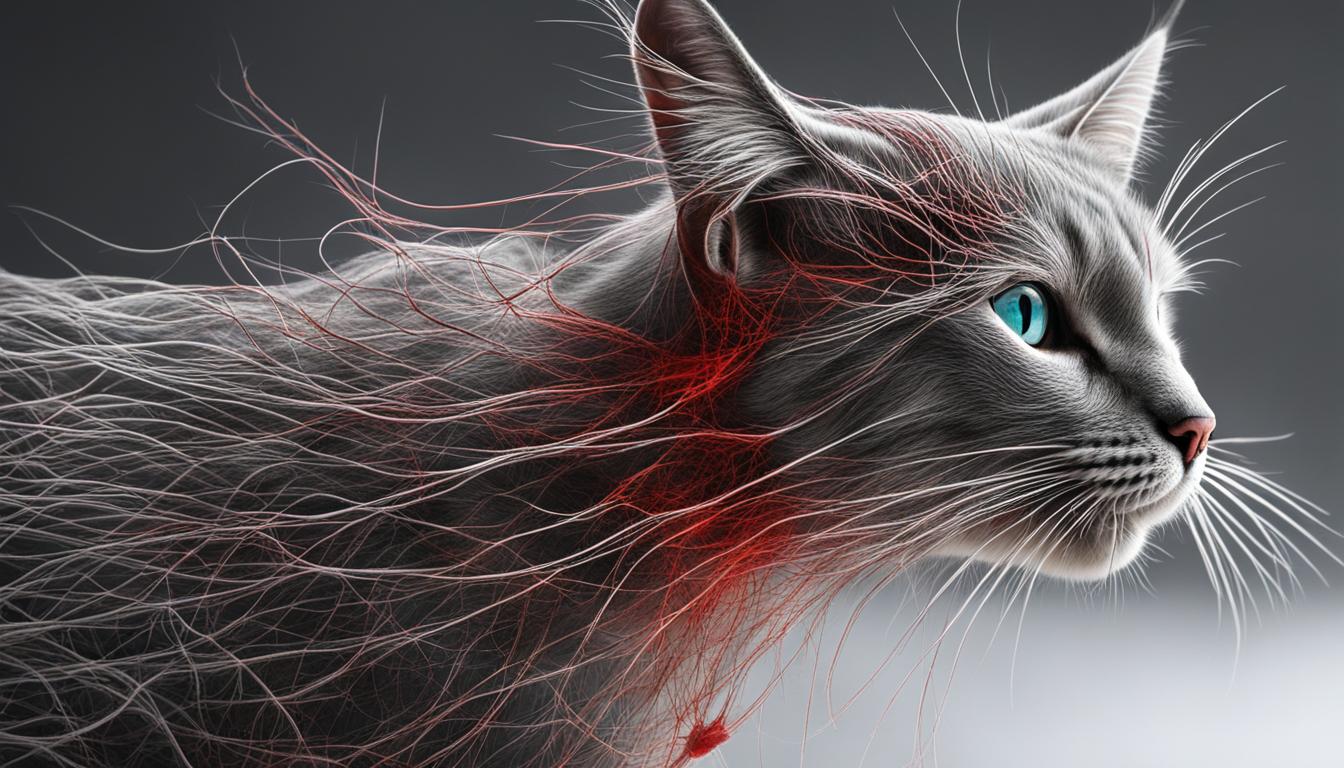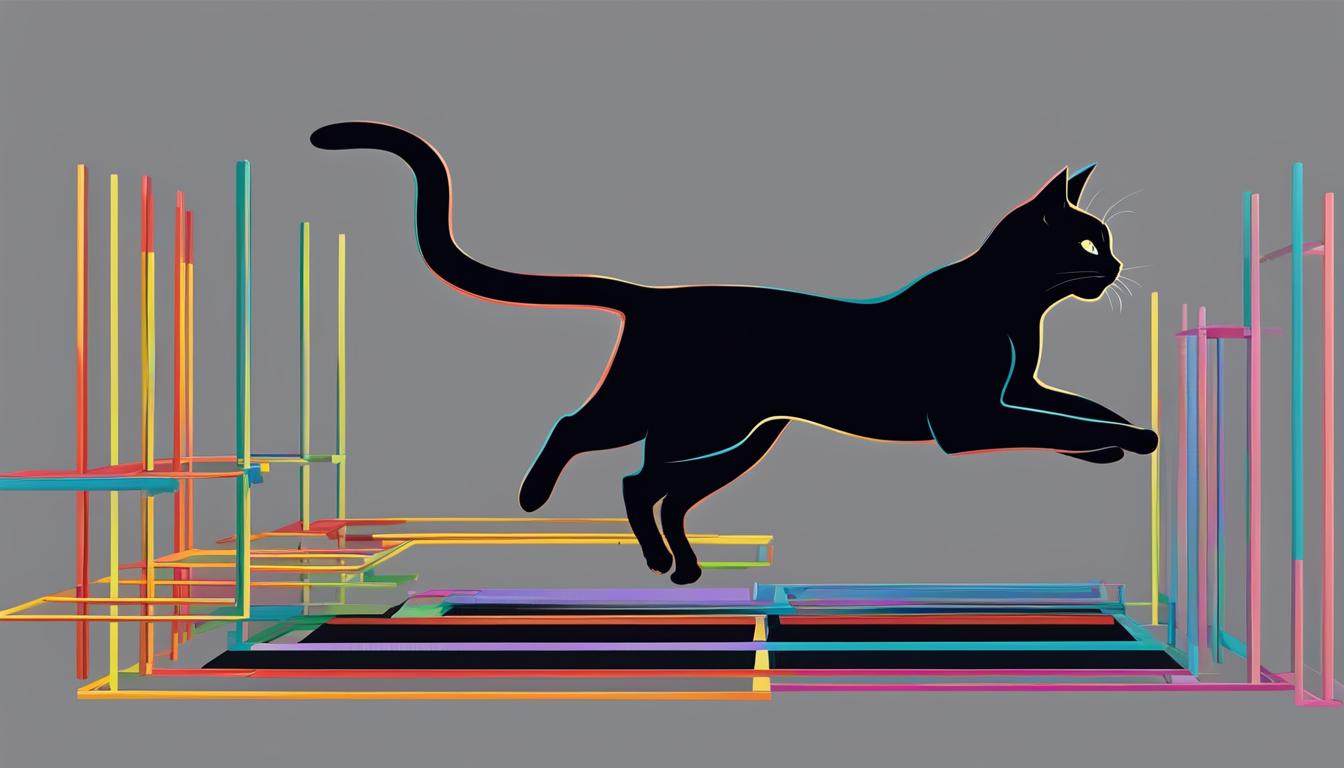I’m always amazed by the incredible abilities of cats, especially when it comes to their whiskers. Have you ever wondered why cats have those long, delicate hairs protruding from their faces? Well, it turns out that cat whiskers, or vibrissae, serve a fascinating biological purpose.
From a biological perspective, cat whiskers are not just ordinary hairs. They function as a sensory organ, supplementing or even substituting for short-distance vision. Each whisker acts as a mechanical transducer, conveying forces along its shaft to mechanoreceptors in the follicle at the base. This allows cats to make highly accurate discriminations of object distance, direction, and surface texture.
What’s even more fascinating is that cat whiskers have been preserved throughout the evolution of terrestrial mammals. Their tapered and circular cross-section provides advantages for tactile perception, making them an essential tool for cats in navigating their surroundings.
Key Takeaways:
- Cat whiskers, or vibrissae, serve as a specialized sensory organ for cats.
- Whiskers supplement or substitute for short-distance vision.
- Each whisker functions as a mechanical transducer, conveying forces for accurate object perception.
- The tapered and circular cross-section of whiskers enhances tactile perception.
- Whiskers have been preserved throughout the evolution of terrestrial mammals.
The Structure and Function of Cat Whiskers
Cat whiskers, also known as vibrissae, have a unique structure that enables them to perform various functions essential to a cat’s day-to-day life. These specialized sensory organs play a crucial role in tactile perception, object detection, and environmental exploration.
The structure of cat whiskers is distinct from regular body hair. They are large hair follicles with a larger basal diameter and are heavily innervated and vascularized. Whiskers project from the face at different angles and are controlled voluntarily by the cat, allowing them to gather crucial information about their surroundings. The whisker follicles contain mechanoreceptors, which convert mechanical forces along the shaft into nerve signals that are then sent to the brain.
Functionally, cat whiskers serve as mechanical transducers, converting physical forces applied to the whiskers into sensory information. They provide the cat with the ability to detect touch, determine distance and direction of objects, perceive vibrations, and analyze surface textures. Whisker taper and flexibility are crucial for tactile perception, as they allow the cat to make precise discriminations and navigate their environment with accuracy.
Understanding the structure and function of cat whiskers gives us insight into the remarkable sensory abilities of these fascinating creatures. It allows us to appreciate their unique way of perceiving the world and their reliance on touch and tactile cues for survival.
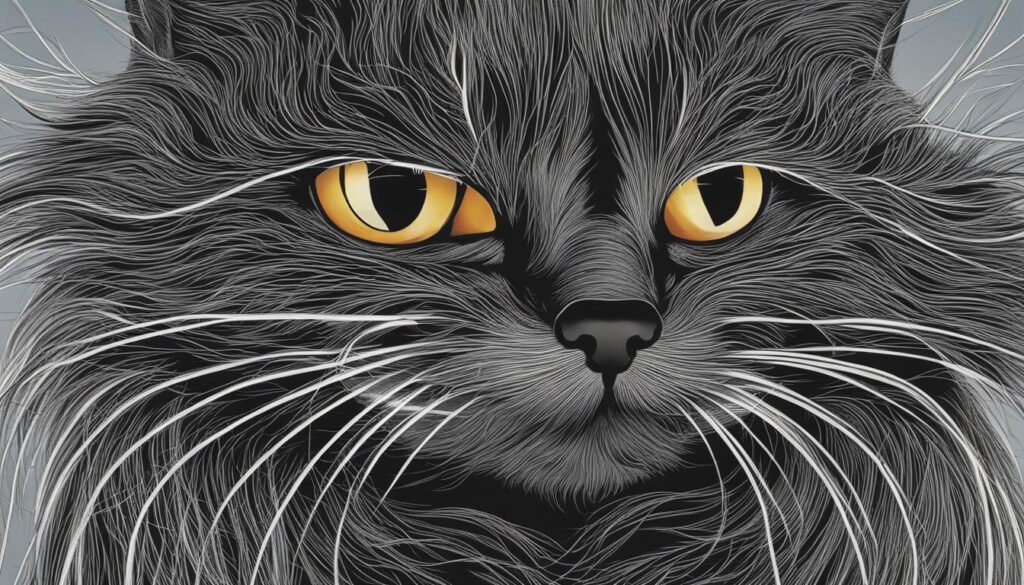
Table: Comparing Whisker Structure and Function
| Aspect | Whiskers | Regular Body Hair |
|---|---|---|
| Structure | Large hair follicles with a larger basal diameter | Smaller hair follicles with a regular diameter |
| Innervation | Heavily innervated with mechanoreceptors | Less innervated |
| Function | Sensory perception, object detection, texture discrimination | Insulation, protection |
Sensory Adaptation in Cat Whiskers
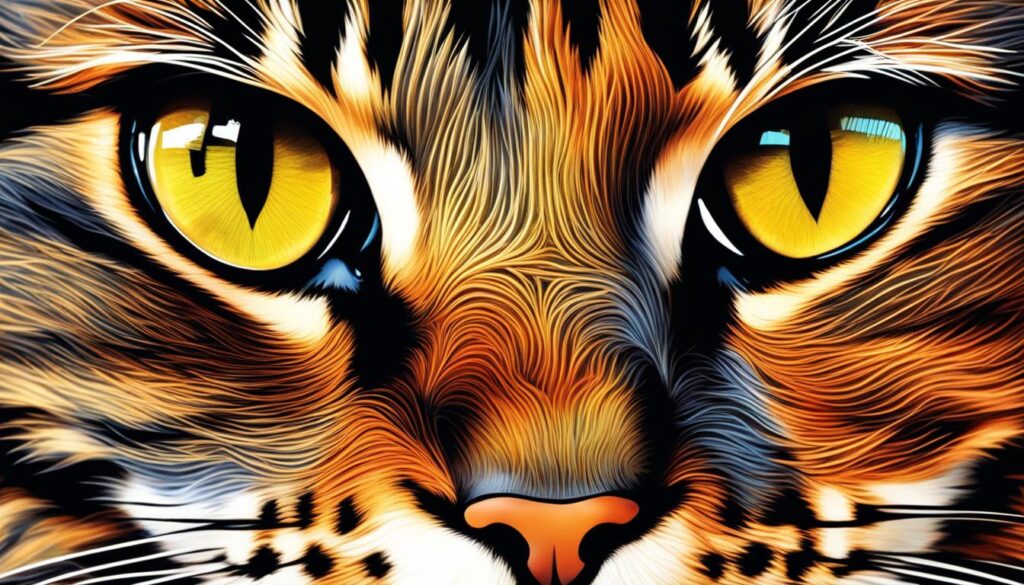
When it comes to cat whiskers, their sensory abilities go beyond just detecting touch and texture. These remarkable appendages also exhibit a fascinating phenomenon known as sensory adaptation. Neurons in the whisker sensory pathway have been found to adapt their response to repeated or sustained whisker stimulation, varying depending on the parameters of the stimulation.
Research has shown that the degree of adaptation in cat whiskers can be influenced by factors such as stimulation frequency, amplitude, and velocity. When a whisker is continually stimulated, the neuronal responsiveness to that particular stimulus can decrease over time. This adaptation allows the cat’s sensory system to filter out less relevant information and focus on detecting new or changing stimuli.
Interestingly, sensory adaptation in cat whiskers can also enhance neuronal responses under certain circumstances. When the stimulation regime changes, such as a different amplitude or velocity, the neurons may exhibit increased responsiveness. This adaptive mechanism ensures that the cat’s sensory system remains dynamic and responsive to the ever-changing environment.
The Diversity of Sensory Adaptation
The adaptation profiles observed in cat whiskers are diverse, with different neurons exhibiting varying degrees of adaptation. This diversity emphasizes the complexity and specificity of the cat’s sensory system. Additionally, sensory adaptation in cat whiskers often leads to an increased response latency. The neuronal response may be delayed due to the adaptive mechanism, allowing the cat’s brain to process and interpret the sensory information appropriately.
The understanding of sensory adaptation in cat whiskers extends beyond just the neurons in the whisker sensory pathway. It has been observed and quantified in various regions of the cat’s brain, including the trigeminal ganglion, brainstem, sensory thalamic nuclei, and somatosensory cortex. This widespread adaptation across different levels of neural processing further highlights the importance of sensory adaptation in the overall functioning of the cat’s sensory system.
| Neuronal Response | Stimulation Parameters | Adaptive Mechanism |
|---|---|---|
| Decrease in responsiveness | Repeated or sustained whisker stimulation | Filtering out less relevant information |
| Increased responsiveness | Change in stimulation regime | Adapting to new or changing stimuli |
“Sensory adaptation in cat whiskers is a remarkable phenomenon that allows for the cat’s sensory system to dynamically respond to its environment. The diversity of adaptation profiles and increased response latency further highlight the complexity of this sensory mechanism.”
Understanding sensory adaptation in cat whiskers provides valuable insights into the intricate workings of the feline sensory system. It underscores the remarkable adaptability of cats in processing and interpreting sensory information, enhancing their ability to navigate their surroundings and interact with their environment effectively.
Whisker Communication and Behavior Significance
Whiskers, also known as vibrissae, are not just decorative features on a cat’s face – they play a crucial role in communication and behavior. These specialized sensory organs are rich in nerve endings, allowing cats to gather vital information about their surroundings and interact with others.
One of the key functions of whiskers is to detect subtle changes in air currents and vibrations. This sensory ability aids in navigation and prey detection, enabling cats to move with precision and accuracy. When a cat extends its whiskers forward, it amplifies its sensory perception, helping it navigate narrow spaces or judge the distance between objects.
“Whiskers can be seen as a cat’s GPS system, providing valuable information about their environment,” says Dr. Jane Collins, a renowned veterinarian.
Moreover, whiskers are used by cats to communicate with each other. By detecting slight variations in the position and movement of another cat’s whiskers, felines can convey their emotions and intentions. Whisker movements can indicate levels of arousal, aggression, or familiarity, allowing cats to interact and establish social hierarchies.
Understanding the significance of whisker communication and behavior can deepen our connection with our feline companions. By respecting their need for personal space and observing their whisker movements, we can better understand their moods and preferences. So, next time you notice your cat’s whiskers twitching, remember that it’s their way of talking to you!
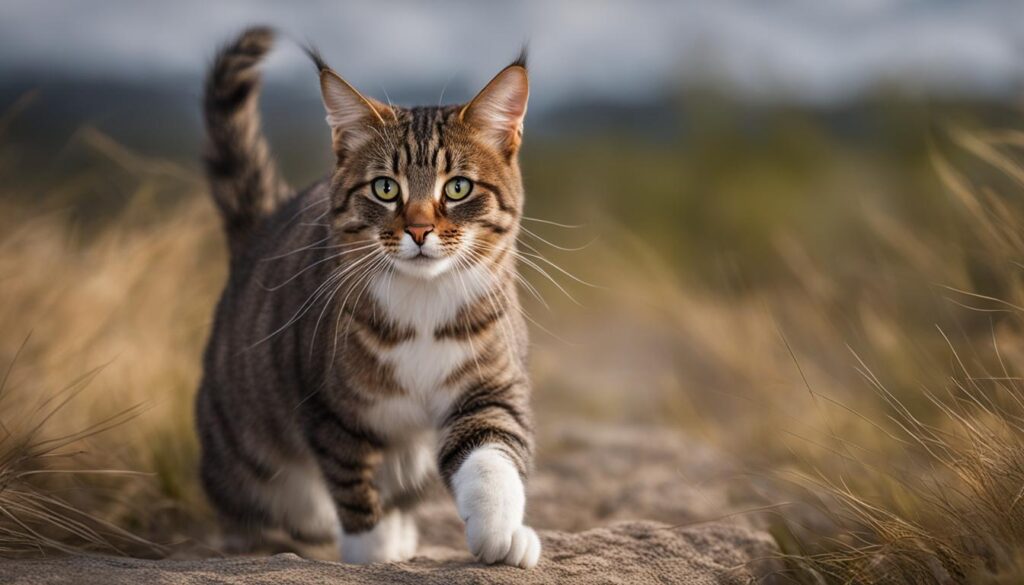
Whisker Length and Breed Variations
When it comes to cat whiskers, length is not a one-size-fits-all attribute. Different cat breeds exhibit variations in whisker length, which can have an impact on their sensory abilities. Some breeds are known for having longer whiskers, while others have shorter ones. Let’s take a closer look at how whisker length varies among different feline breeds and the implications it has on their perception of the world.
The Maine Coon, known for its majestic appearance, typically boasts longer whiskers compared to other breeds. These impressive whiskers can reach lengths of up to six inches or more. On the other hand, breeds like the Siamese or the Sphynx tend to have shorter whiskers in comparison. This variation in whisker length is determined by genetic factors, just like other physical traits of cats.
So, what does whisker length mean for cats? Longer whiskers provide a wider range for sensory detection, allowing cats to gather more information about their surroundings. With longer whiskers, cats can detect changes in their environment with greater accuracy, enabling them to navigate through tight spaces and hunt prey more effectively. On the other hand, shorter whiskers may limit the range of sensory information that cats can gather, but they can still rely on their other senses to compensate for this.
| Cat Breed | Whisker Length |
|---|---|
| Maine Coon | Long (up to 6 inches or more) |
| Siamese | Short |
| Sphynx | Short |
Table: Whisker Length Variation in Different Cat Breeds
While whisker length can vary among cat breeds, it’s important to note that every cat’s whiskers serve a vital function in their sensory perception. Whether long or short, cat whiskers are a fascinating feature that contributes to their understanding of the world around them.
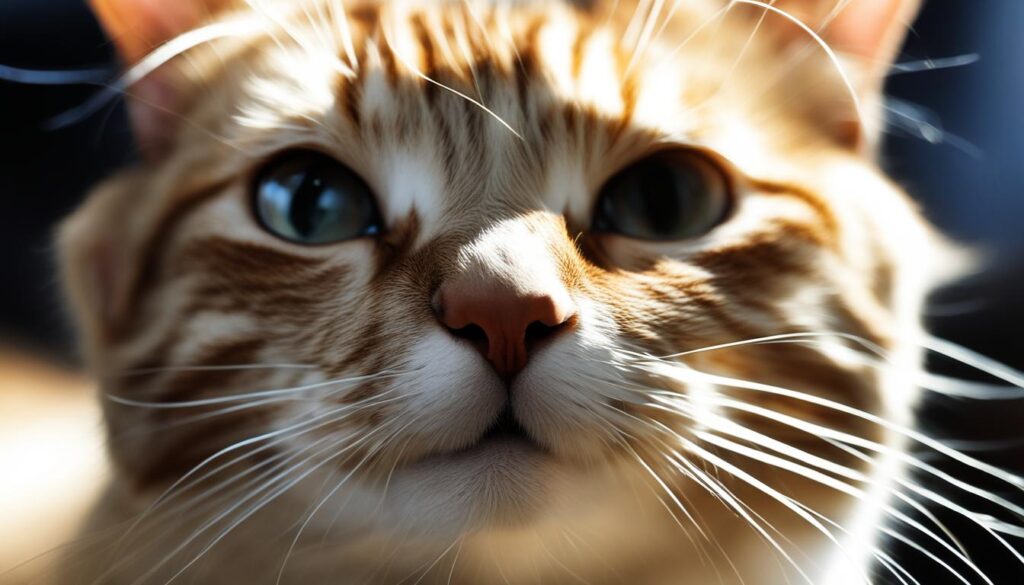
Whisker Stress and Fatigue in Cats
Whiskers are not just stylish facial accessories for cats; they serve a vital sensory function. However, these sensitive appendages can also experience stress and fatigue, especially in confined spaces or when they come into contact with objects. Whisker stress occurs when a cat’s whiskers are compressed or deflected beyond their normal range of motion, causing discomfort or even pain. This can happen when a cat tries to squeeze through a narrow opening or navigate tight corners. Whisker fatigue, on the other hand, occurs when a cat’s whiskers are overstimulated or constantly subjected to touch or friction.
Whisker stress and fatigue can have negative effects on a cat’s overall well-being. When cats experience whisker stress, they may become anxious or avoid situations that trigger discomfort. They may also lose confidence in their ability to navigate their surroundings, leading to a decrease in exploration and play. Whisker fatigue can cause sensory overload, resulting in stress and irritability. Cats may become more reactive or exhibit signs of aggression when their whiskers are constantly stimulated.
As responsible cat owners, it is important to provide our feline friends with enough space to move freely and avoid situations that can cause whisker stress or fatigue. Avoid confining cats to small spaces or placing objects that could compress or overstimulate their whiskers. Creating an enriching environment with plenty of vertical space, scratching posts, and interactive toys can help alleviate whisker stress and provide cats with opportunities for natural movement and exploration.
Table: Common Causes of Whisker Stress and Fatigue in Cats
| Causes | Effects |
|---|---|
| Tight spaces and narrow openings | Potential discomfort and anxiety |
| Overstimulation of whiskers | Sensory overload and irritability |
| Constant contact with objects | Discomfort and potential loss of confidence |
Sources: First source
Conclusion
After diving deep into the fascinating world of cat whiskers, I am amazed by their biology and sensory capabilities. These delicate yet powerful appendages serve as a unique sense organ, giving cats a remarkable tactile perception that complements their short-distance vision.
Through their whiskers, cats can discern object distance, direction, and even surface texture with astonishing accuracy. It’s truly remarkable how their whiskers act as mechanical transducers, converting external forces into sensory information that their brains can interpret. This tactile prowess is a testament to the intricate design of the feline whiskers.
But the wonders of cat whiskers do not end there. These remarkable sensory tools also play a crucial role in the communication and social interactions of our feline friends. By detecting subtle changes in whisker position and movement, cats can convey their emotions and intentions to one another. Whether it’s signaling familiarity, arousal, or aggression, whisker communication is an essential part of their behavioral repertoire.
Understanding the biology and function of cat whiskers allows us to appreciate the sensory marvels of our furry companions. It opens up new avenues for enhancing our interactions with them and deepens our connection with these remarkable creatures. So, next time you observe your cat’s whiskers in action, take a moment to marvel at their sensory prowess and the unique world they uncover.
FAQ
What is the function of cat whiskers?
Cat whiskers, or vibrissae, supplement or substitute for short-distance vision. They allow cats to perceive object distance, direction, surface texture, vibrations, and changes in air currents. They also play a crucial role in communication and social interactions among cats.
How do cat whiskers work?
Each whisker functions as a mechanical transducer, converting forces applied along its shaft to tissue forces in the follicle. The mechanoreceptors in the follicle-sinus complex send signals to the brain, allowing for perception of touch, distance, direction, vibrations, and texture.
Do cat whiskers vary in length?
Yes, the length of cat whiskers can vary depending on the breed. Genetic factors determine whisker length, which can contribute to differences in hunting capabilities and spatial awareness.
Can cat whiskers experience stress and fatigue?
Yes, cats can experience whisker stress and fatigue, especially in confined spaces or when their whiskers come into contact with objects. Whisker stress occurs when the whiskers are compressed or deflected beyond their normal range of motion, causing discomfort or pain. Whisker fatigue can occur when the whiskers are overstimulated or constantly subjected to touch or friction.
How can I prevent whisker stress and fatigue in my cat?
It is important to provide cats with enough space to move freely and avoid situations that can cause whisker stress or fatigue. Ensuring that food and water bowls are wide enough for the cat’s whiskers to avoid contact can also help prevent discomfort.

